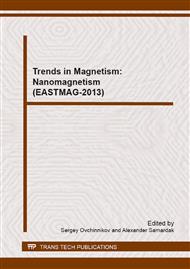p.259
p.264
p.268
p.272
p.278
p.284
p.288
p.292
p.298
Effect of Substrate RF-Bias on Exchange Coupling in Fe20Ni80/Fe50Mn50 Films
Abstract:
The effect of physical and technological factors on the effectiveness of the exchange coupling in two-layer film structures such as Fe20Ni80/Fe50Mn50 has been investigated. The dependences of the coercive force and the exchange bias field of permalloy layer on presence of a buffer Ta layer and its thickness, the order of sputtering and the thickness of Fe20Ni80 and Fe50Mn50 layers, substrate temperature and the features of radio-frequency (RF) substrate bias during deposition were investigated. It has been found that the substrate RF bias improves homogeneity of microstructure and reduces the surface roughness of permalloy layer. This in turn increases the magnetic pinning of permalloy layer and creates the prerequisites for the practical application of layered structures with higher thickness of the ferromagnetic layers.
Info:
Periodical:
Pages:
278-283
Citation:
Online since:
April 2014
Keywords:
Price:
Сopyright:
© 2014 Trans Tech Publications Ltd. All Rights Reserved
Share:
Citation:


